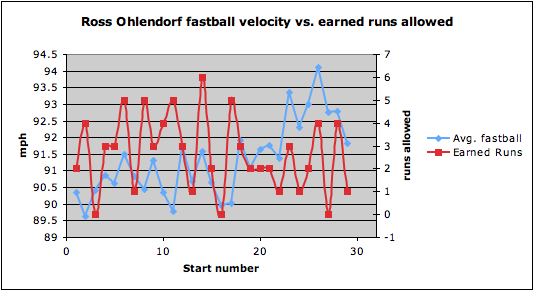When we last left Ross Ohlendorf’s PitchFX case, we were examining the spike in velocity that he flashed in the middle of August. So did it continue through the rest of the season?

More after the jump
It’s pretty clear here that it did. Starting with his 21st start against the Nats, he started getting his average fastball up around 92 and his max started regularly topping 94, sometimes even getting into the 96-97 range. He also tailed off a bit in his last three starts, which is maybe a sign that that the Pirates shutting him down was a good idea.
Of course the big question, though, isn’t whether or not he threw harder. It’s whether or not he pitched better. Just for fun, I made a graph showing Ohlendorf’s fastball speed plotted with runs allowed on a separate axis.

This graph admittedly tells us very little other than the fact that Ohlendorf didn’t really get rocked after his first start in July, which we knew anyways. Of course, that more or less correlates with the jump in average fastball speed, but really I just wanted to make a graph with two y-axes.
More truth lies in the hard numbers themselves, though. Through those first twenty starts, Ohlendorf sported a 4.51 ERA with 64 strikeouts and 34 walks in 117 2/3 innings. Ratewise, that’s 4.9 Ks and 2.6 BBs per nine innings and a hair under six innings per start. Opponents hit .276/.333/.457 against him with 15 homers (1.14/9), and his GB/FB ratio was 1.23. There’s nothing special there; not a lot of groundballs or strikeouts or a low number of walks. He was pretty much a boring, run of the mill fourth starter.
In those last nine starts, Ohlendorf posted a 2.75 ERA with 45 strikeouts and 19 walks in 59 innings. Translated to rates for comparison’s sake, that’s 6.9 Ks and 2.9 BBs in starts that went about 6 1/3 innings. Opponents batting line dropped to .212/.278/.423 with ten homers (1.52/9) and a GB/FB ratio of 1.55.
So the increase in velocity brought an increase in strikeouts, which made Ohlendorf harder to hit and keyed his success in the final third of the season. The questions that stem from here, I think, are how that change in velocity affected his pitch selection, his breaking pitches (ie, did he make a mechanical change to bump fastball velocity up that affected his breaking pitches as well?) and the movement on his fastball. Note that the increase in fastball speed didn’t necessarily make him a power pitcher; if we extrapolated his last nine starts to a 162 game season, he’d only have 171 strikeouts. That’s not a bad total, but that doesn’t make him a strikeout pitcher either. These questions will be the jumping-off point for the next post, which will go a bit more in depth.




















